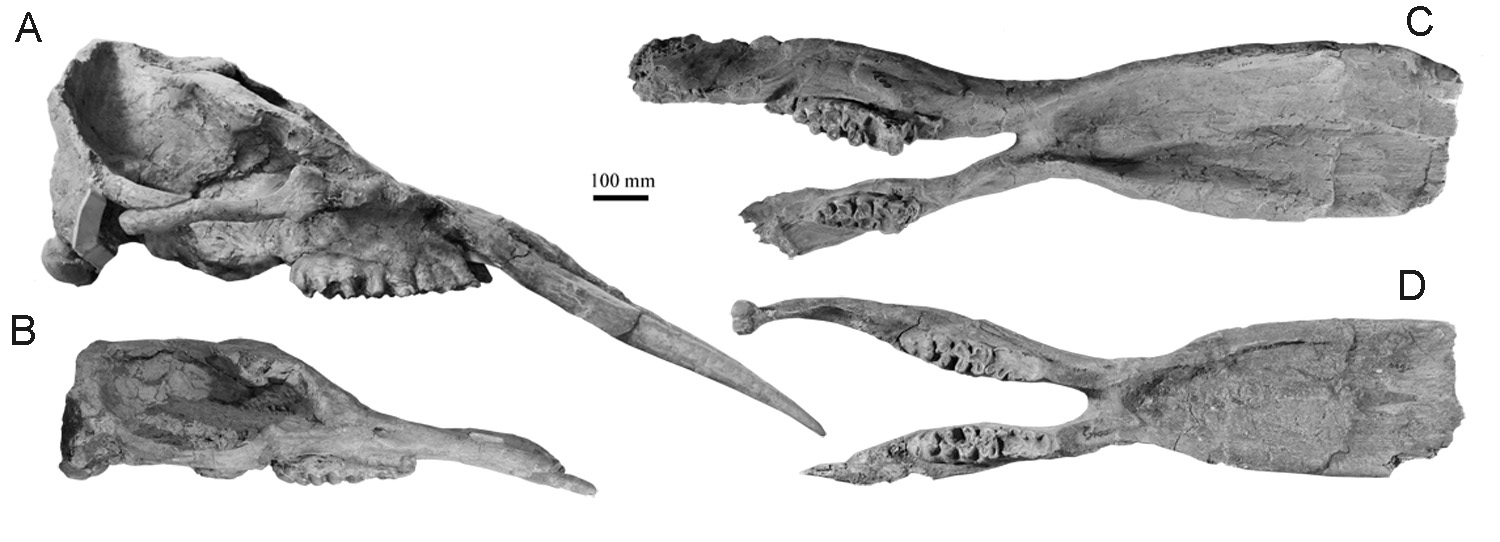Platybelodon is a group of extinct Proboscidea with an elongated and flattened mandibular symphysis, known as “Shovel-tusked” elephant. They extended from the early Miocene to middle Miocene of Eurasia, and some of them reached North America in the late Miocene. During recent 20 years, researchers from Institute of Vertebrate Paleontology and Paleoanthropology, Chinese Academy of Sciences (IVPP) and Hezheng Paleozoological Museum (HPM) found much material of Platybelodon from the Linxia Basin of China, including more than 60 nearly complete skulls and mandibles, hundreds of isolated teeth, and a number of post-cranial bones. In a paper published on the Acta Palaeontologica Polonica (Vol. 58, No. 2), Dr. WANG Shiqi from IVPP and his collaborators from the HPM revised these specimens and compared them with a range of Eurasian taxa, giving a detailed description of its morphological characters and particularly adding some features pertaining to the cranium and the molars. This study provides a discussion of evolutionary trends and functional adaptations of Eurasian platybelodonts.
The Linxia Basin is located in the northeastern corner of the Tibetan Plateau in western China. Most of the fossils were discovered from two sites of late Middle Miocene Hujialiang Formation of the Linxia Basin, Zengjia and Laogou. These specimens resemble the type and other material of Platybelodon grangeri from the Zone I of the Tunggur Area in: the portion of the length to width of the mandibular symphysis, the loph(id) number of the cheek teeth, the complexity of the crown pattern, and the heaviness of cementum. Thus, specimens from Zengjia and Laogou were assigined to Platybelodon grangeri.
The skulls from the Zengjia site show strong sexual dimorph. Adult males, except having stronger upper tusks, generally possess higher arched neurocranium and more posteriorly positioned nasal bones than adult females. The adult mandibles are also able to divide into two types: one with relatively narrow and long symphysis and the other with short and broad one. They are determined as male and female, respectively. It seems that the characters of males are more derived than that of females, and the juveniles is more similar to females than males. Furthermore, cheek teeth from the Laogou site is slightly more derived than that from the Zengjia site.
Platybelodon from the localities of Ganchiliang and Citan in the early Middle Miocene Dongxiang Formation of the Linxia Basin resembles to the type species Platybelodon danovi from the Kuban Region, Caucasus Area. The teeth is relatively simple, and the transverse symphyseal ledged is absent on the madibular symphysis. Researchers assigned these specimens to Platybelodon danovi.
Researchers performed a cladistic analysis in order to test the systematic affinities of the material from Linxia, and explore the evolutionary interrelationships of the Eurasian occurrences of Platybelodon. The evolutionary relationships of known Platybelodon were also discussed. They generally constitute a continuously evolutionary series. In this sequence, the loph(id) number of m3 and M3 increased and some individuals from the Zone II from Tunggur even had tetralophodont m2 and M2. The complexity of crown pattern and the heaviness of the cementum of the cheek teeth rose.
In the Linxia Basin, the Hujialiang Formation consists of a set of fluvial strata composed of grayish−yellow conglomerates and sandstone, suggesting that Platybelodon might have lived near rivers or swamps. With the aid of an enlarged trunk, the elongated mandibular symphysis and the shovel−like lower tusk may have assisted Platybelodon in the harvest of marshy weeds, while the posteriorly tilted ramus and the robust transverse ledge on the mandibular symphysis ensured mechanical stability of the lower jaws. Platybelodon was well adapted to marshy environments, and was widespread throughout eastern Asia in the late Middle Miocene. However, at the end of the Middle Miocene, the genus went extinct in Eurasia, possibly owing to environmental changes and competition from “true” elephantids.
This work was supported by the Strategic Priority Research Program of the Chinese Academy of Sciences, the Ministry of Science and Technology of China, and the National Natural Science Foundation of China.

Fig.1 Platybelodon grangeri from the Linxia Basin of China. A, male cranium; B, female cranium; C, male mandible; D, female mandible.(Image by Wang Shiqi)
|